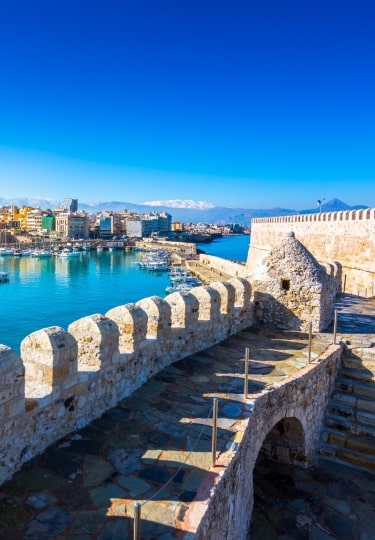In the buzzing capital of Crete, the largest of Greece’s islands, there are plenty of things to do in Heraklion.
Set on the island’s north-central coast, the city is surrounded by golden beaches and backed by the vast mountains that run along the Crete’s spine, making it the gateway to an adventure playground for those who love everything from swimming to hiking.
While a thoroughly modern city, Heraklion is also steeped in history, from the incredible Minoan ruins at Knossos to the medieval Venetian architecture that runs throughout. There are ancient sites, the rugged outdoors, bustling markets, and fiery local spirits to try, which means you’ll never run out of things to do in Heraklion.
Marvel at the Knossos Palace
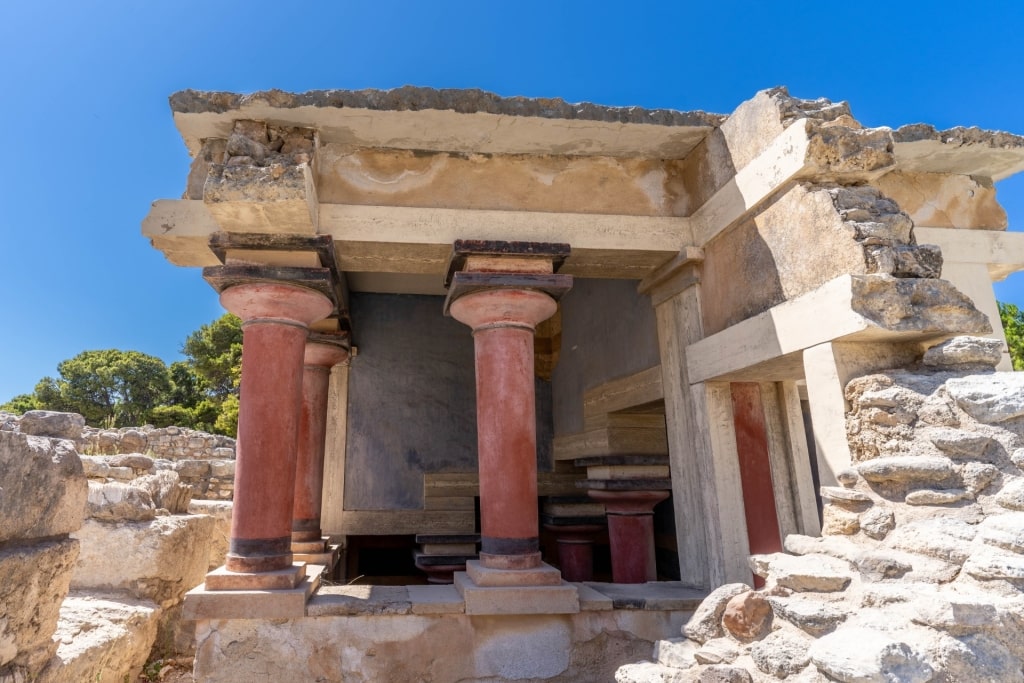
Knossos Palace
The Minoan civilization was one of the leading lights of the Bronze Age, its influence spreading far and wide from its central home of Crete. Known for its architecture and art, it’s widely considered Europe’s first civilization.
Likewise, its leading city Knossos, just outside Heraklion, is also considered to be the oldest city in Europe, and a visit here is considered one of the best things to do in Heraklion. More than 4,000 years old, the remains of the city and its central palace are some of the best preserved in Europe, a site of historical fact and famous legends.
It’s said that the Palace of Knossos was home to a labyrinth that housed the half-man, half-bull Minotaur, a terrible monster that gave the Minoans their power. The tale of its defeat by Athenian prince Theseus remains one of the enduring stories of Greek mythology, as originally told in Plutarch’s ancient tome “Life of Theseus”.
Walk the City Walls
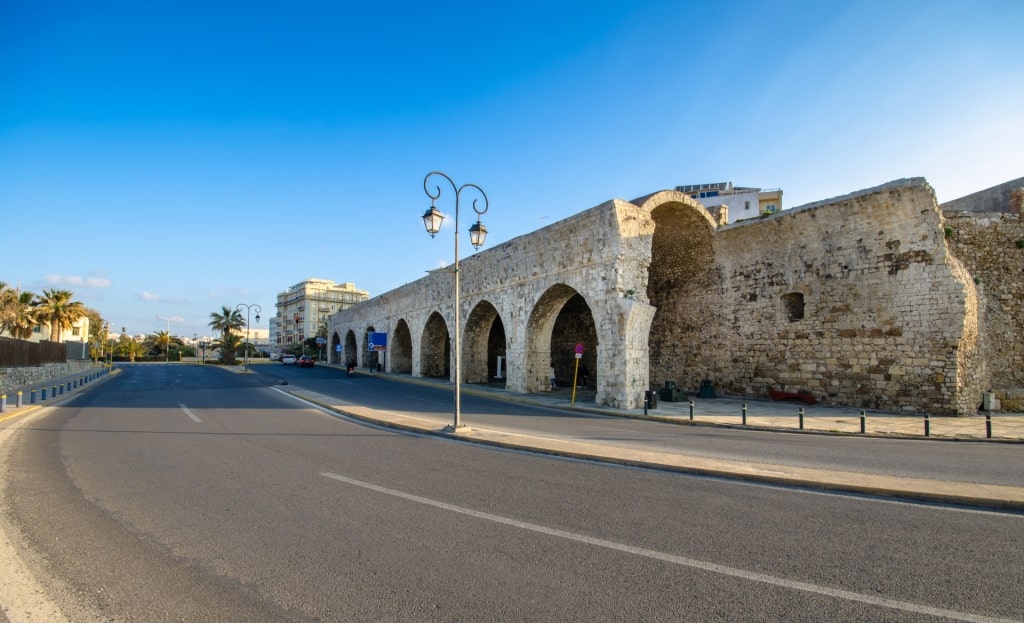
Heraklion City Walls
Like many of the Greek islands, Crete and its capital Heraklion were under Venetian rule in the Middle Ages, with constant attacks by pirates, requiring the city to be adequately fortified.
Heraklion’s city walls were originally built in the Byzantine era and were completely rebuilt by the Republic of Venice in medieval times to the point they were so strong they withstood a 21-year siege by the Ottomans before falling in 1669.
Built in a somewhat triangular shape, the remains of the walls and their various gates and bastions now stretch for some 2.5 miles and can be explored today either individually or on walking tours with guides who offer interpretative stories about their origin and use.
Delve Into the Past at the Archaeological Museum
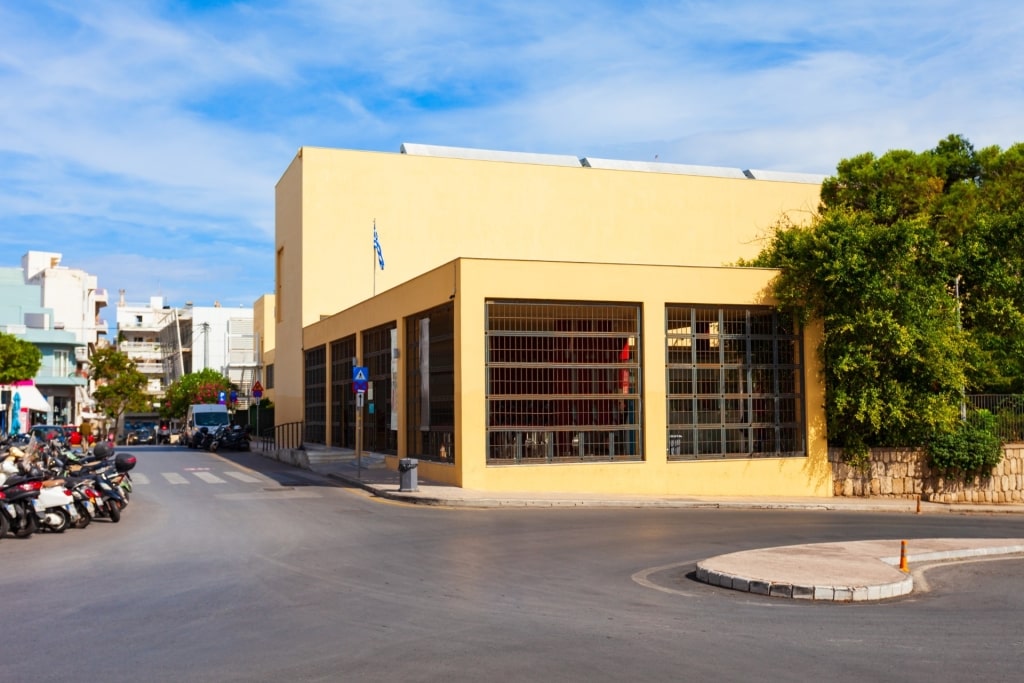
Archaeological Museum
For those looking to put Crete’s Minoan history into context and wondering what to do in Heraklion, the Archaeological Museum is the answer.
Founded as a small collection of antiquities in 1883, it acquired a permanent home in a modernist town-center building in 1940 and has since gone on to become one of Greece’s largest museums. It houses what is regarded as the best and most complete collection of Minoan artifacts in the world.
The museum consists of some 20 galleries, with exhibits ranging from 6000 BC and the period prior to the building of the Palace of Knossos, to sculptures from the Classical Greek and Greco-Roman periods. The museum has differing opening times depending on the time of year, so do call and check before visiting.
Browse Heraklion’s Markets
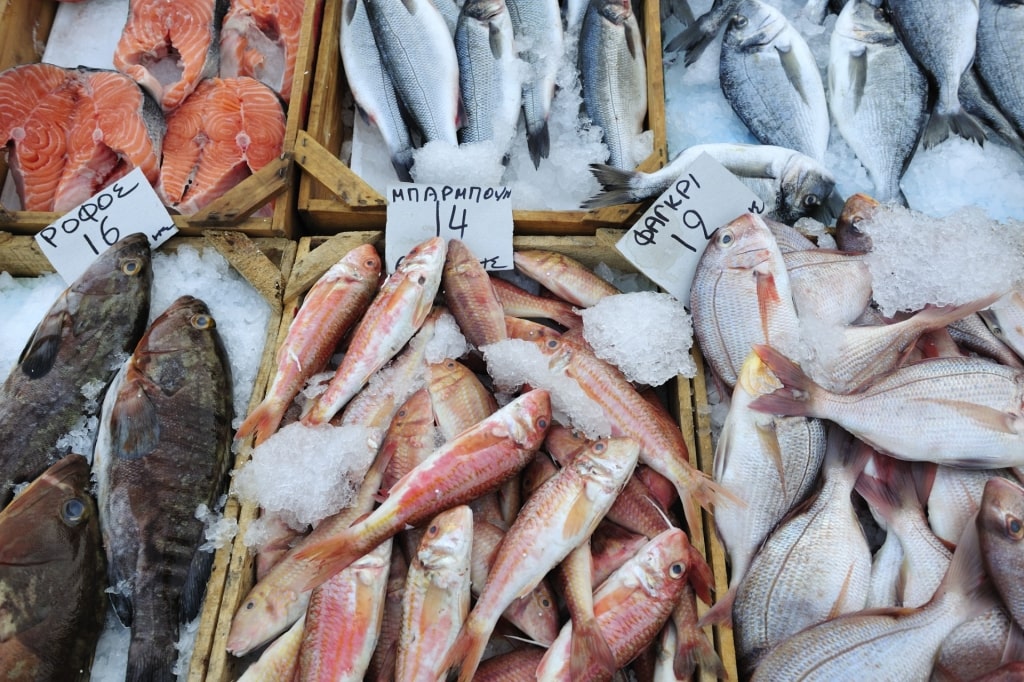
Fish
A great way to get under the skin of the city, live life more like a local, and enjoy one of the best things to do in Heraklion is to visit the city’s markets.
The main market runs along the central cobbled 1866 Street, named after an important uprising in the battle of independence from the Ottomans. Here are dozens of stalls selling everything from souvenirs to aromatic herbs, fruit, vegetables, fish, cheeses, and traditional sweets.
To the south of the city, off Itanou Street, lies another space: the Open Air Bazaar of Heraklion—a vast bustling flea market that is also well worth a browse.
Read: Best Things to Do in Crete
See the Lions at the Morosini Fountain
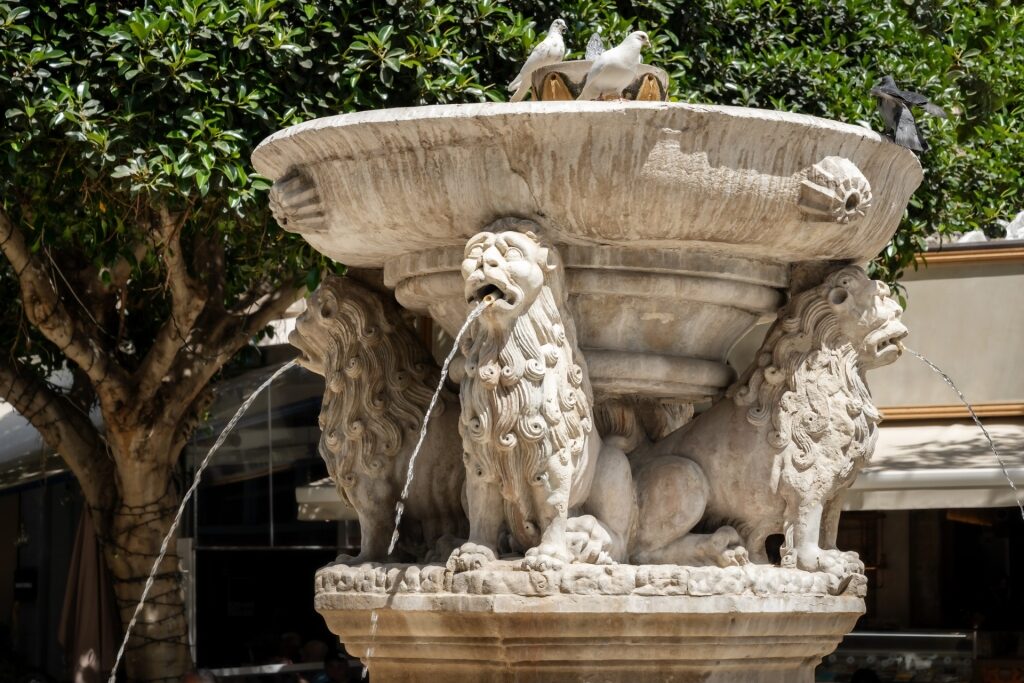
Morosini Fountain
The Venetians who occupied much of Crete for so long were certainly masters at making something functional look beautiful. A great case in point is the Morosini Fountain.
Set in Heraklion’s central square, this elegant fountain was built by Venetian noble Francesco Morosini in medieval times to solve the city’s water shortage problem. The culmination of an almost 10-mile long aqueduct, it brought water from Mount Juktas to the town.
The fountain was constructed in such a way that up to 40 people could receive water from the four ornamental lions’ heads that act as spouts.
Today, it’s one of the city’s most photographed spots and while the water flows freely, it should be noted it is no longer drinkable.
Light a Candle at Agios Minas Cathedral
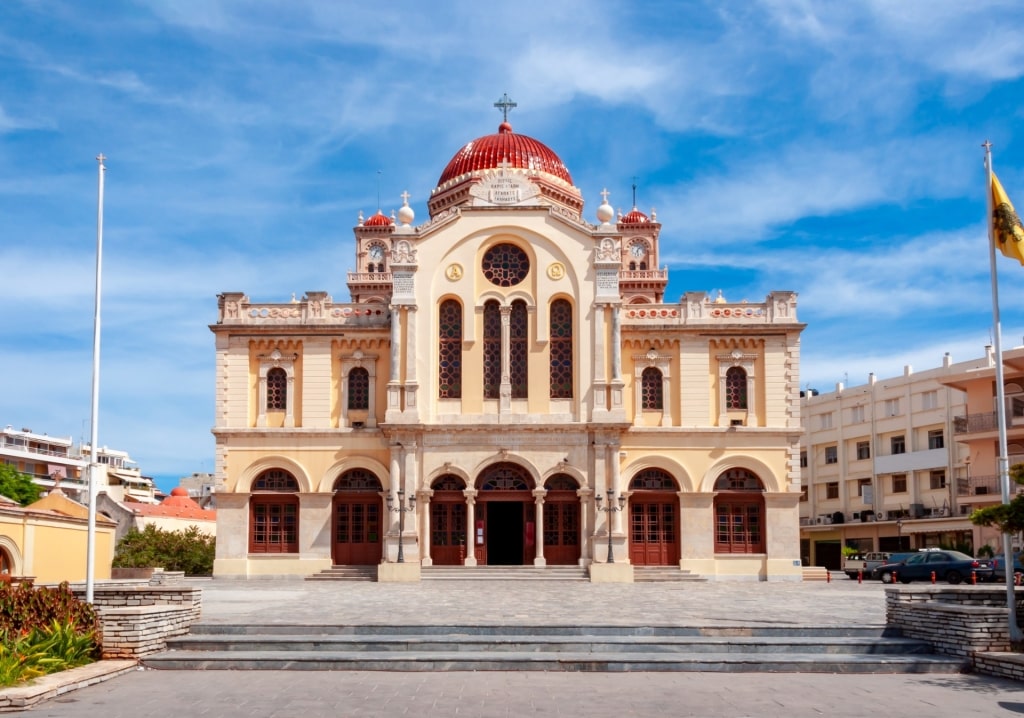
Agios Minas Cathedral
The seat of the Archbishop of Crete, Agios Minas is the central church of Heraklion and is dedicated to Saint Minas, a third-century martyr and miracle worker who is the city’s patron saint. The imposing church, the largest on the island, dominates a large public square off a street that shares its name with the church itself.
The church’s ornate but somewhat sober exterior hides a richly decorated interior with ornate chandeliers and incredibly detailed icons of various saints and religious images. Lighting candles in memory or in support of loved ones is a Greek tradition and there are silver sand pits in which to place the flaming candles.
Simply make a small donation, light the candle from one already aflame, and place it standing in the sand. Do note that to visit a Greek church, it is polite for all visitors to have covered shoulders and knees.
Admire Koules Fortress
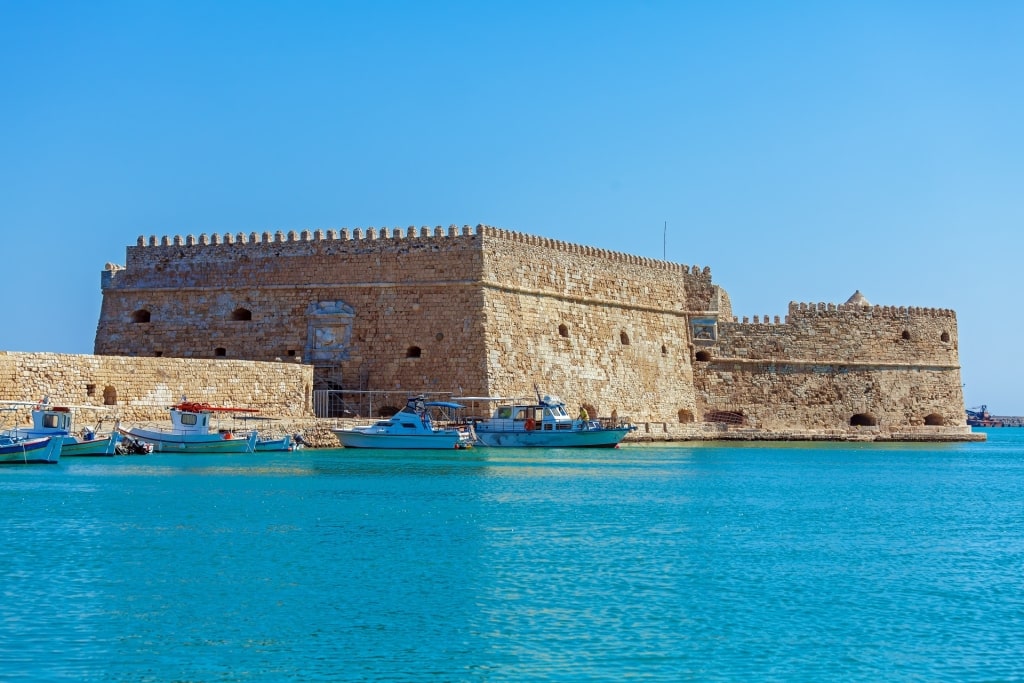
Koules Fortress
Part of the Venetian defenses of the city, Koules Fortress sits sentinel-like at the entrance to Heraklion’s harbor.
Despite being built in 1540 on a base of landfill created by filling old ships with stone and sinking them in the harbor, the fort remains in near-perfect condition thanks to an elegant restoration program.
Today, the fort is visited by thousands of people each year, while it is often used for cultural events including concerts, theater performances, and art shows.
Go Back in Time at the Natural History Museum of Crete
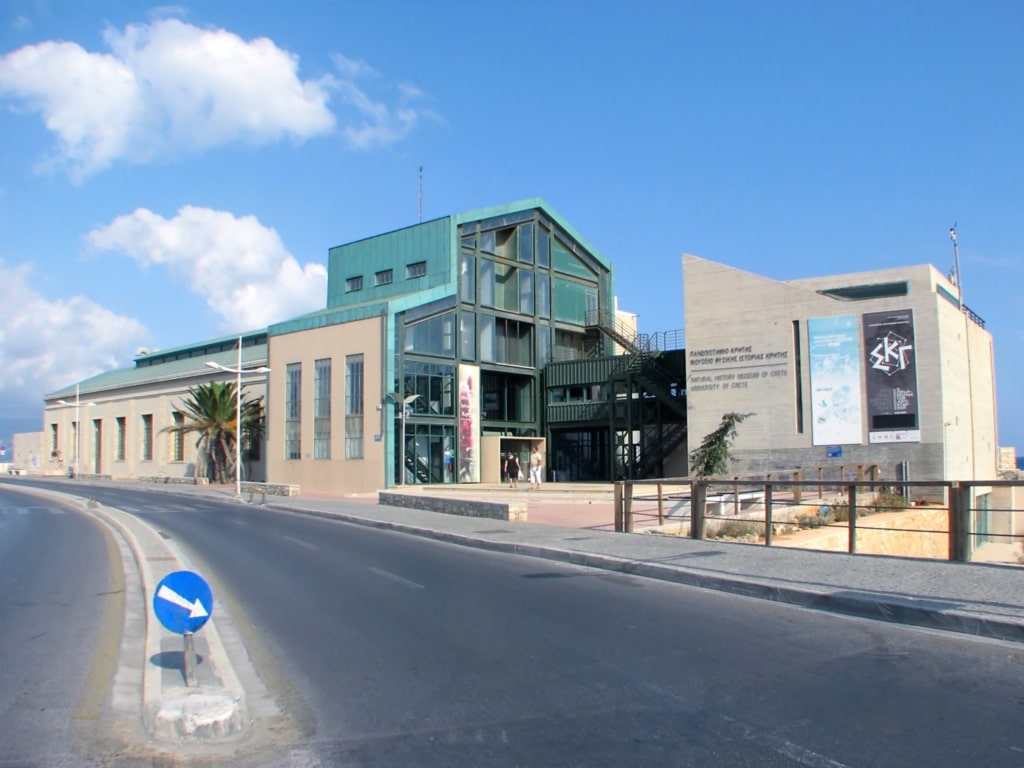
Natural History Museum of Crete Photo by Lourakis on Wikimedia Commons, licensed under CC BY-SA 3.0
Set in a former electricity plant to the west of Heraklion’s Old Town, the Natural History Museum of Crete was established by the University of Crete in 1980 to help spread knowledge about the natural environment of Crete and the Eastern Mediterranean.
Featuring interactive exhibits, the museum hosts 16 permanent collections, including galleries dedicated to high mountains, coniferous forests, wetlands, and deserts. There’s also a botanical garden with replica dinosaurs that would once have roamed here.
Crete is at the center of much geothermal activity and one room provides a unique earthquake simulator experience with mock quakes able to reach the equivalent of a whopping 7.6 on the Richter scale.
Gaze at the Venetian Loggia
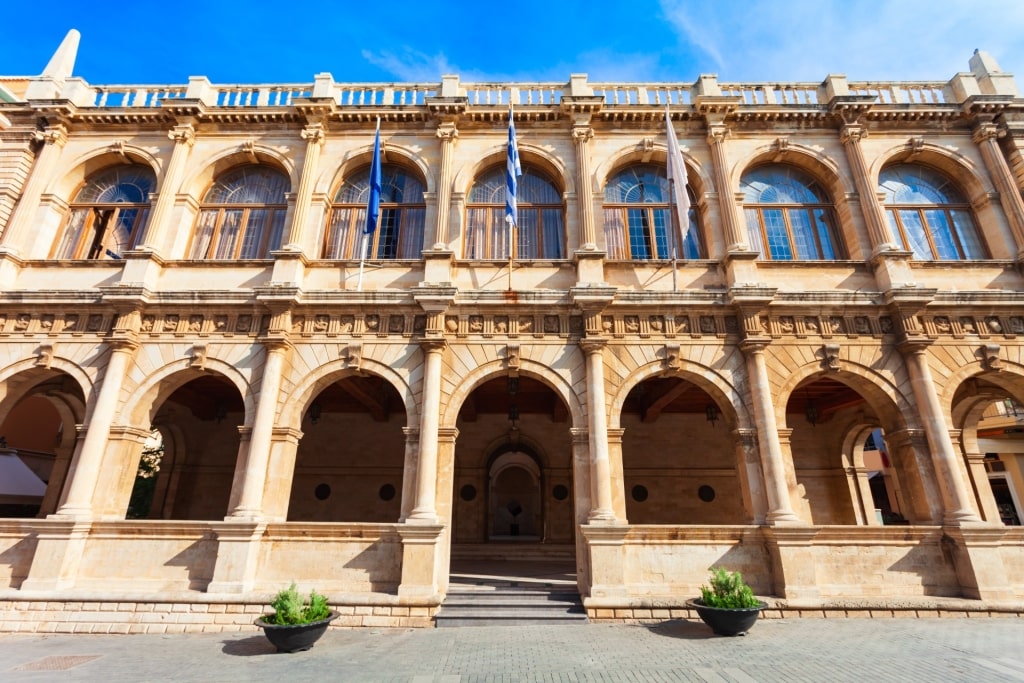
Venetian Loggia
One of the most unique structures left by Venetian rule is this two-story lodge, close to the Morosini Lions Fountain. The Loggia now acts as the city hall. Built in 1628, also under the aegis of Francesco Morosini, the lodge was originally used by noblemen to discuss local politics and commerce.
The elegant building is said to have been inspired by the Basilica Palladiana in Vicenza and despite its storied past it has had a checkered history. Almost destroyed by an earthquake in 1856, it was scheduled for demolition in the early 20th century before it was saved by a renovation program that started in 1915.
Financial constraints and two world wars meant the project was not completed until 1980, but the Loggia won a European restoration award in 1987 before going on to become the town hall.
Pay Respects at the Tomb of Kazantzakis
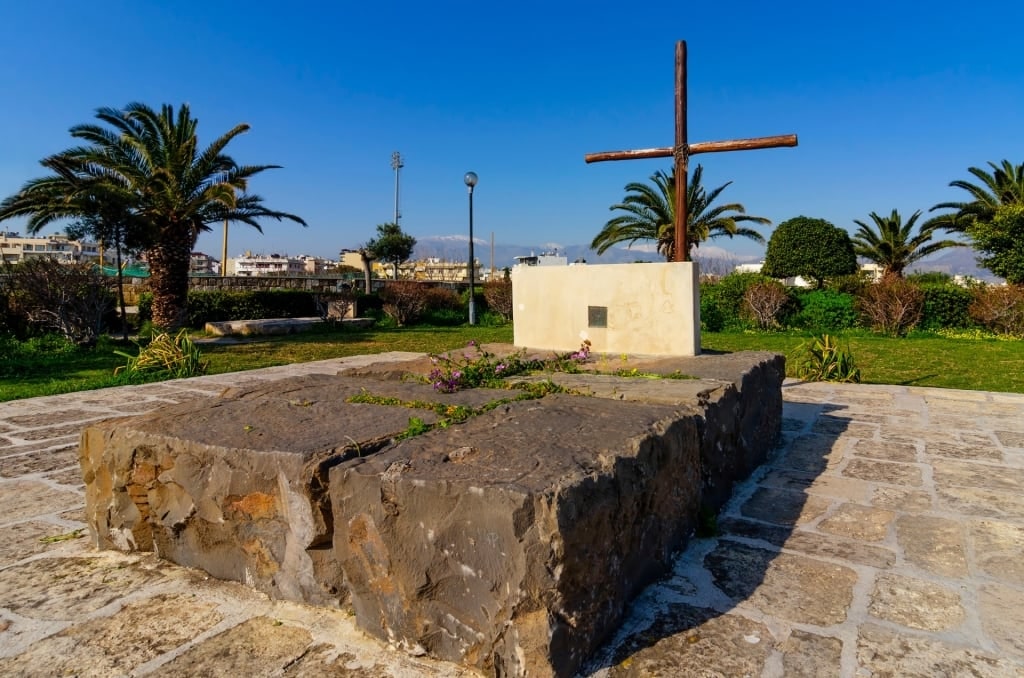
Tomb of Kazantzakis
One of Crete’s most notable sons is Nikos Kazantzakis, international best-selling author, playwright, journalist, and translator.
Kazantzakis was famed for his pioneering spirit and liberal philosophy and his body was returned to Crete after his death in 1957 and entombed at the southwestern corner of Heraklion’s old Venetian city walls. He was not allowed a Christian burial as he’d been excommunicated by the Greek Orthodox Church.
His tomb is marked by the legend: “I hope for nothing, I am afraid of nothing, I am free.” For those looking for a deeper dive into his life, the well-curated Nikos Kazantzakis Museum sits in the village of Myrtia, a 20-minute drive south of this Greek city.
See Sea Life at the Cretaquarium
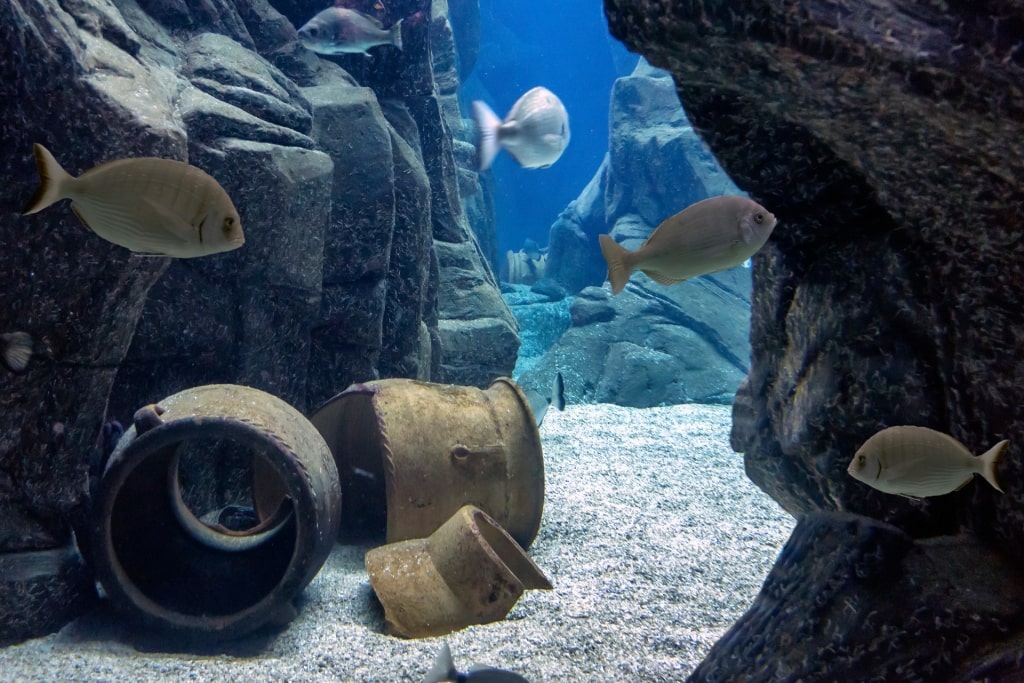
Cretaquarium
With a coastline stretching for more than 650 miles, Crete’s relationship with the sea is a close one. A great place to learn more about that relationship is this aquarium 10 miles east of the city in the Cretan village of Gournes.
The aquarium consists of 61 tanks housing some 2,500 animals, including red scorpionfish, common stingray, tiger sharks, and loggerhead sea turtles. Past the many interactive exhibits, there’s also a souvenir shop, and a café offering sea views. A rarity by Greek standards, the aquarium is open 365 days a year.
Visit Mysterious Spinalonga Island
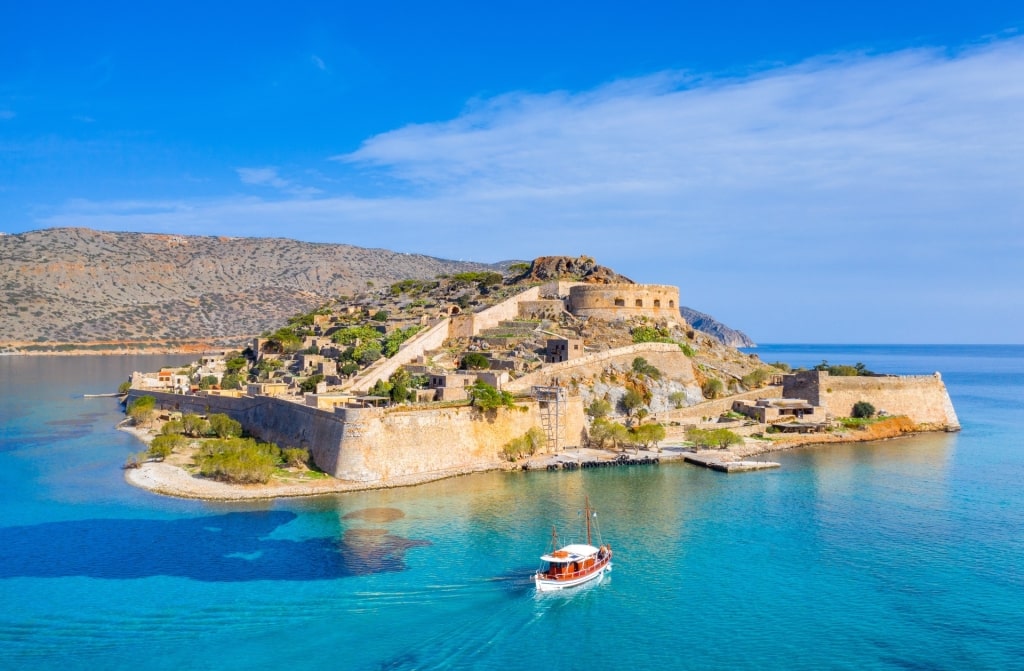
Spinalonga Island
An hour’s drive east of Heraklion lies the town of Agios Nikolaos from where a short boat ride takes visitors to one of the most storied islands in Greece. Spinalonga was variously a fortress under Venetian rule and then a hideaway for Cretans of Turkish descent following independence from the Ottoman Empire.
The 1900s though saw its notoriety increase when it became a leper colony. Though people were ostensibly sent here to die, in a triumph of human spirit they formed societies, fell in love, married, and lived a life far from that of normal society.
The colony was finally closed in 1957 and its operation considered to be a blight on the Greek state. The heart-warming yet tragic story of its residents is now told in a series of exhibits so evocative it is Crete’s second most visited tourist site and the sixth in the country overall.
Admire Art at El Greco Museum
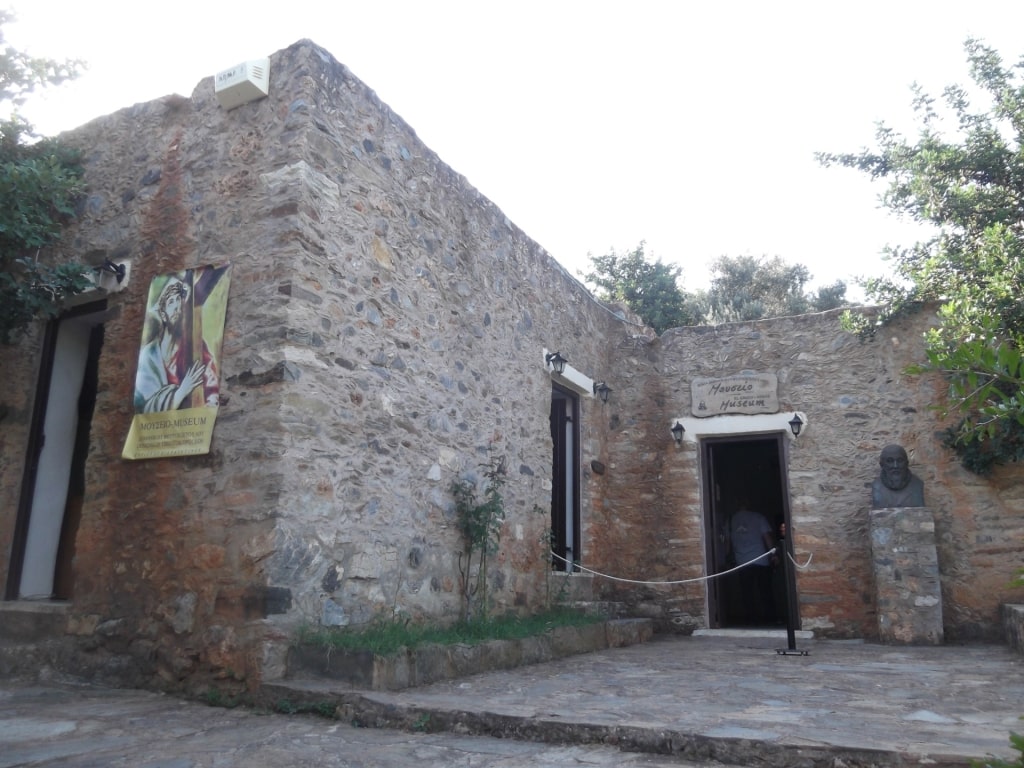
El Greco Museum Photo by Jpbowen on Wikimedia Commons, licensed under CC BY-SA 3.0
Domenikos Theotokopoulos, the world-renowned mannerist painter known as El Greco vies with Nikos Kazantzakis as one of Crete’s most famous sons.
While most of his fame came while living in Spain during the Spanish Renaissance, hence his nickname, El Greco, his home village of Fodele, a 30-minute drive west of Heraklion, houses a museum in his honor.
In a small house said to be his birthplace there are replicas of his paintings and documents about his life. Back in Heraklion, the Historical Museum of Crete hosts two of his original paintings, the only ones on Crete.
Look for Fairies at the Cave of Astraki
One of Crete’s most whimsical sights lies 15 miles south of Heraklion near the abandoned village of Kato Astraki. In the majestic gorge of Astraki lies a two-story cave thought to have once been an ancient place of worship, but now said to be the home of mythical fairies.
With a small lake and several streams and falls, the rush of water is said to resemble their cries, while there are several carvings of fairies in the surrounding rocks. Whether a walk here sees you spot one may be open to question, but it’s a lovely relaxing spot to visit nonetheless.
Sample Raki Spirit
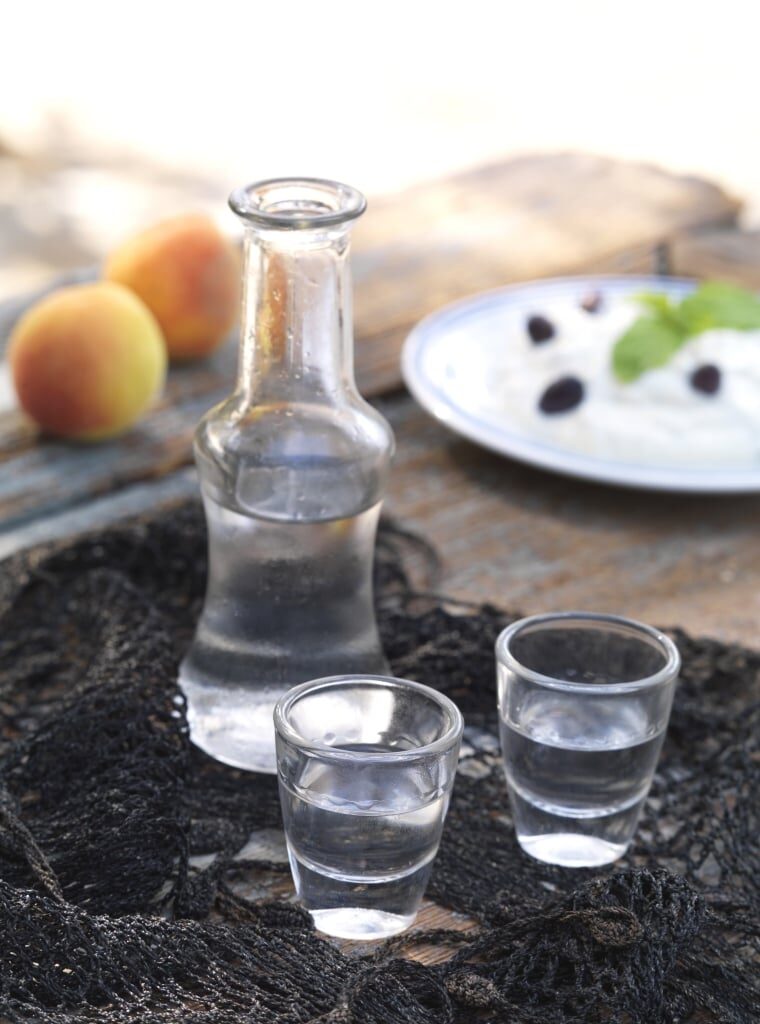
Raki
Almost every celebration in Crete, including greeting people for the first time, is met with a glass of “raki” or “tsipouro”, a clear pomace brandy that packs a real punch, especially given the tradition to drink it shot-style in one.
Shops, bars, restaurants, and cafés may all greet visitors with an icy-cold glass of the good stuff. If you decide to imbibe, it pays to pace yourself for safety’s sake.
Read: Best Beaches in Greece
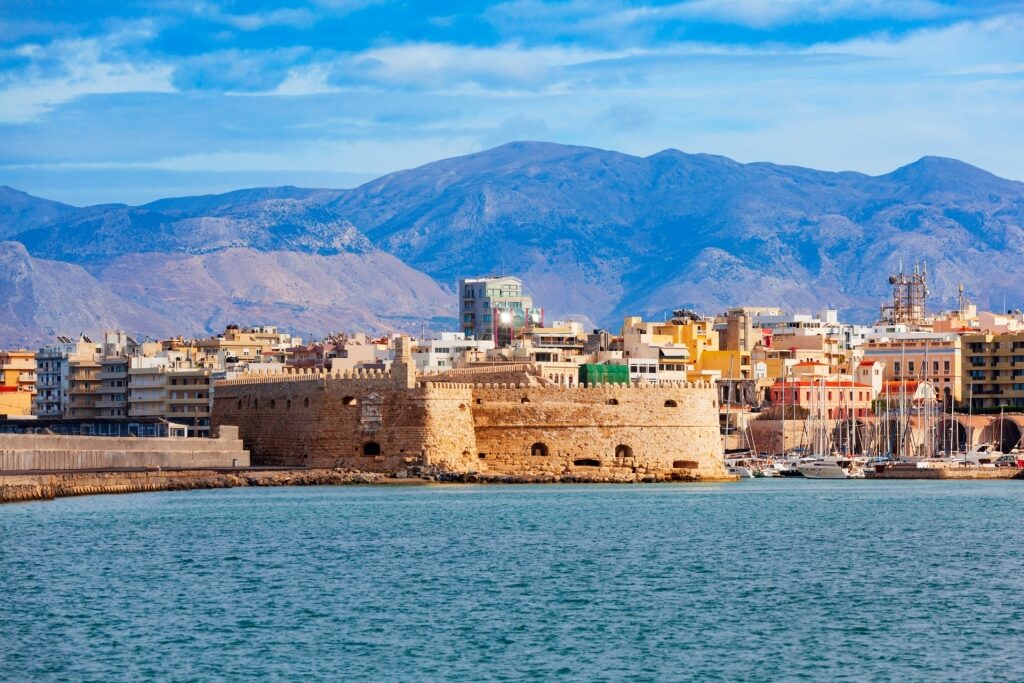
Koules Fortress
Discover your next Greek Island adventure with Celebrity Cruises. Browse Celebrity’s cruises to Heraklion and book your getaway.
